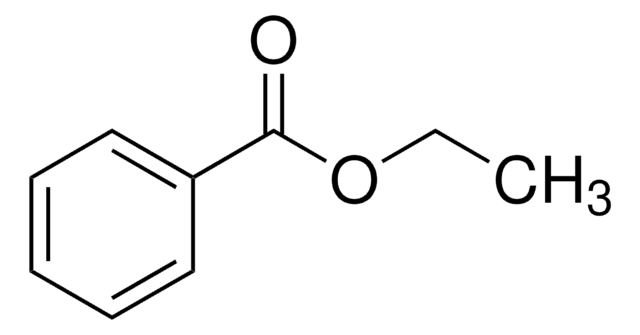Key Documents
About This Item
Polecane produkty
klasa czystości
analytical standard
Poziom jakości
gęstość pary
5.17 (vs air)
ciśnienie pary
1 mmHg ( 44 °C)
Próba
≥99.0% (GC)
temp. samozapłonu
914 °F
okres trwałości
limited shelf life, expiry date on the label
metody
HPLC: suitable
gas chromatography (GC): suitable
zanieczyszczenia
≤0.5% water
współczynnik refrakcji
n20/D 1.504 (lit.)
n20/D 1.504-1.506
tw
212 °C (lit.)
mp
−34 °C (lit.)
gęstość
1.045 g/mL at 25 °C (lit.)
Zastosowanie
cleaning products
cosmetics
flavors and fragrances
food and beverages
personal care
format
neat
ciąg SMILES
CCOC(=O)c1ccccc1
InChI
1S/C9H10O2/c1-2-11-9(10)8-6-4-3-5-7-8/h3-7H,2H2,1H3
Klucz InChI
MTZQAGJQAFMTAQ-UHFFFAOYSA-N
Szukasz podobnych produktów? Odwiedź Przewodnik dotyczący porównywania produktów
Powiązane kategorie
Opis ogólny
Zastosowanie
- Japanese soy sauce by headspace solid-phase microextraction-aroma extraction dilution analysis-gas chromatography-olfactometry (HS-SPME-AEDA-GC-O) as well as GC combined with mass spectrometry (GC-MS).
- Honeybush tea (Cyclopia spp.) by HS-SPME and comprehensive two-dimensional gas chromatography (GC x GC) with time-of-flight mass spectrometry (TOFMS).
- Cherry wine samples by HS-SPME coupled to GC-MS equipped with electron impact (EI) ionization, and selective ion monitoring (SIM) detection.
- Monstera diliciosa fruits by HS-SPME-GC with quadrupole EI-MS.
Kod klasy składowania
10 - Combustible liquids
Klasa zagrożenia wodnego (WGK)
WGK 1
Temperatura zapłonu (°F)
190.4 °F - closed cup
Temperatura zapłonu (°C)
88 °C - closed cup
Wybierz jedną z najnowszych wersji:
Masz już ten produkt?
Dokumenty związane z niedawno zakupionymi produktami zostały zamieszczone w Bibliotece dokumentów.
Klienci oglądali również te produkty
Nasz zespół naukowców ma doświadczenie we wszystkich obszarach badań, w tym w naukach przyrodniczych, materiałoznawstwie, syntezie chemicznej, chromatografii, analityce i wielu innych dziedzinach.
Skontaktuj się z zespołem ds. pomocy technicznej














